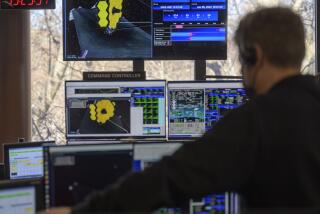China to explore outer space with its huge new radio telescope
- Share via
Reporting from Beijing — What’s the size of 30 football fields, hunts for aliens and lurks in the forests of southwest China?
The world’s largest single-aperture radio telescope, of course.
China completed construction on the telescope — the $180-million Five-hundred-meter Aperture Spherical Telescope, or FAST — this week by hoisting the last of its 4,450 triangular panels into place.
Pictures posted online showed the vast, gray, disk-shaped structure nestled among the lush trees and karst cliffs of Guizhou, one of China’s poorest provinces. It had been under construction since 2011 and is expected to begin operations in September.
“The project has the potential to search for more strange objects to better understand the origin of the universe and boost the global hunt for extraterrestrial life,” said Zheng Xiaonian, deputy head of the National Astronomical Observation under the Chinese Academy of Sciences, which built the telescope, according to the official New China News Agency.
China is on a bit of a space kick. In April, President Xi Jinping, called for China to become an “aerospace power.” Beijing launched 19 space missions in 2015 and hopes to up that tally this year. It spends $2 billion to $3 billion annually on its space program, with hopes to eventually put an astronaut on the moon. (NASA will spend $19 billion this year).
FAST, with its 1,640-foot diameter, is not actually the world’s biggest radio telescope — that honor goes to the RATAN telescope in Russia’s Caucasus Mountains, a “multi-element-reflector radio telescope” whose surface elements are not connected by one joining structure. (RATAN looks like a ring; FAST looks like a dish). FAST’s surface can shift to form a parabolic mirror, affording scientists greater flexibility and control.
The world’s second largest single-aperture radio telescope is Puerto Rico’s Arecibo Observatory, completed in 1963, which is just under 1,000 feet in diameter. FAST will be able to detect radio waves up to 1,000 light years away — three times farther than Arecibo — and will generate five terabytes of data daily.
“With [FAST], we can explore pulsar, black holes swallowing small objects, the evolution of stars, and the origins of the universe, and connect it with other radio-telescopes within the country to create a virtual super telescope,” Science Communication China, an official institute under the China Association for Science and Technology, said in a February column that was widely republished online in recent days.
Curiosity about outer space is related to a country’s economic development.
— Zhang Huawei, astrophysics professor at Peking University
FAST is located in Pingtang, a remote county in one of Guizhou’s high mountain valleys. While the structure was under construction, authorities relocated more than 9,000 villagers living within a three-mile radius to prevent magnetic disruptions. Even a cellphone could potentially interfere with incoming signals. Each was given $1,800 in compensation.
“Curiosity about outer space is related to a country’s economic development,” said Zhang Huawei, an astrophysics professor at Peking University. “The most developed countries, like the U.S. and in Western Europe, they’re also very good at astronomy. We think that exploring the whole universe is the responsibility of the human race. The more money you have, the more responsibility you shoulder.”
As for the likelihood of finding aliens?
“We have no idea about that,” Zhang said.
Yingzhi Yang in the Times’ Beijing bureau contributed to this report.
ALSO
Apple sued in China over showing of war film from the 1990s
Juno arrives at Jupiter: ‘It’s the end of the voyage, but it’s the beginning of the science’
Taiwan’s deadly misfiring of supersonic missile jolts military rival China
More to Read
Sign up for Essential California
The most important California stories and recommendations in your inbox every morning.
You may occasionally receive promotional content from the Los Angeles Times.










